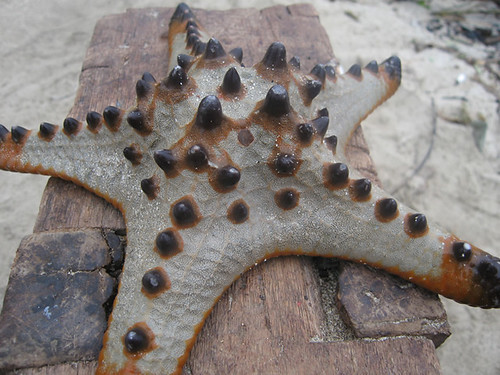 |
| Wonderful Image by Krystle D |
December Greetings! As we get into the holiday and Christmas season, I always get certain questions which pop up around this time of year, asked by the public. One of the common ones I receive around now is (paraphrased)
"Where do those starfish and sand dollars on holiday decorations come from?" Usually followed by "Are they alive?" and etc...
So, let me take a trek through several recurring photos of holiday decorations and show you species by species how they compare.
I have written before on where these decorations come from. A prior overview on starfish here. A prior account on sea urchins (and sand dollars) here.
A general rule about echinoderms used in decorations: WHAT YOU SEE ARE NOT SHELLS, THEY ARE MUMMIES (dried endoskeletons).
 |
| Image by Werner Wittersheim |
So, yes, in order to get one of the starfish dried and made into a wreath? It has to be killed. (that's one of the questions I get about these by the way...)

A starfish tree? really?
Linckia laevigata aka the "Blue Linckia"(although it does occur in other colors) is one of the most heavily fished sea star species in the tropical Indo-Pacific.
This species is "fished" for both holiday trinkets AND the aquarium trade and is probably NOT a good sustainable species for those industries...
3. Archaster typicus
This treats the two specimens at the top of the "wreath".. these are another species which is widely occuring the tropical Pacific.
4. Sand Dollars: Mellita spp.


Mellita spp. are from the tropical Atlantic coast, the Gulf of Mexico, Florida, etc. in shallow water.
Sand dollars are sea urchins! And here's more on that. Those holes in the body (ie. the skeleton also known as the test) are called lunules and they are pretty nifty.
Another commonly encountered species in holiday decorations. Sand dollars, especially these species have the most "benefit of the doubt" because its not unusual to encounter their dead skeletons as beach wash.
Although one has to wonder how much collecting one needs to have enough to create a regularly marketable wreath such as the ones I've been seeing marketed on the Internet...
I'm pretty damn amazed at just how WIDESPREAD these get via the tourist industry. I've literally seen these sand dollars shipped across the country and across the WORLD for sale at tourist shops.
Here is what they look like with all the original spination and such...
and we even got video!
5. Echinometrid? "Sea urchin tree"?
Maybe Echinometra from Australia? Not sure. Like sea urchins, the tests can be gotten as beachwash.. but not regularly. So, I'm thinking these were likely harvested...
So to recap:
1. Starfish decorations are mummified remains of living animals, which had to be killed in order to get you a holiday wreath. I wouldn't lick them.
2. Many of the species used in these industries from the tropical Pacific are probably not sustainable fisheries.
3. Personally, I just think decorating starfishes like Santa Claus is tacky. So, please. just stop. Use sea shells or give people candy. People like candy.
4. Sand dollars are okay. Still possible to kill them for use as decorations. But also possible that they were collected beachwash.
5. Good grief. Who pays 150 dollars for holiday decorations made from beachwash??? or mummified starfish remains??? You know what's good for 150 dollars? chocolate.Send to the Echinoblog. Or charity. charity is good.
So unlike say, shells which are secreted outside or independently of the animal's body, echinoderms have an internal support that is analogous to the skeleton in vertebrates. Their tissue is actually infused into this skeleton.
I've said this before many times. Here and here. I've always found the whole concept of putting echinoderms onto holiday decor as kind of macabre unless you're that guy who puts dead, dried frogs on your Christmas tree, which is perfectly fine....
1. "Knobby Starfish" Holiday Wreath
This is one, I've been seeing around is adorned with large, "Knobby Starfish"
These are Protoreaster nodosus, a species which occurs in the Philippines, Singapore, and all throughout the North-Central tropical Pacific.  |
| Image by Ria Tan (Wild Singapore) |
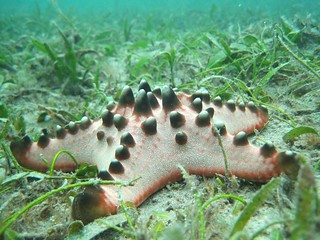 |
| Image by Pau Estrada |
Protoreaster nodosus is an abundant and easily encountered species where it occurs. It is harvested in several places for tourist and gift making decor. A whole industry is oriented around fixing (ie treating with formalin), drying and exporting dried starfishes. I've briefly discussed this here and here
So, there is a fishery of this species, even if people don't eat them. There has been some ongoing work to determine if the species is sustainable (such as this paper by Bos et al.2008). I'm not sure the results are encouraging.
2. Pisaster ochraceus & the "Coastal Wreath"(thanks to Gail for the tip!)
Thanks to the wonders of the Internet and directed marketing, I clicked on the link to this item ONCE. And it now shows up on ALL of my social media and other shopping pages...
The picture actually shows up on several different gift and other sites, which I'll decline to name. But two species are observered here. the starfish is Pisaster ochraceus aka the Ochre Star from the Pacific NW coast and the sand dollar Mellita (prob. Mellita quinquiesperforata ).
Its not unusual for Pisaster to turn up dressed up as any number of awful, tacky holiday decorations

Here again, is a pic of the animal alive to remind you of the contrast...
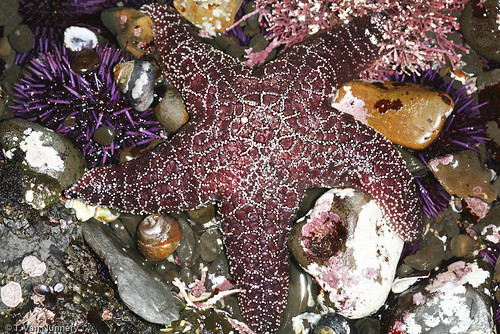 |
| Image by TVN |
 |
| Image by RJAdams55 |
So, the ochre star, the ecologically important keystone predator, which feeds on mussels and so forth. This species, among several others, is currently under attack from starfish wasting disease
 |
| Image from Iamheretokelp |
So, perhaps it is NOT the best species to be turning into garish Christmas and holiday ornaments, eh??
3. "Starfish Wreath" from Linckia laeviagata.
This species is "fished" for both holiday trinkets AND the aquarium trade and is probably NOT a good sustainable species for those industries...
3. Archaster typicus
This treats the two specimens at the top of the "wreath".. these are another species which is widely occuring the tropical Pacific.
This species is seen frequently in the Philippines and in Singapore. Wild Singapore has a nice summary of its biology here Images below from Wild Singapore..
4. Sand Dollars: Mellita spp.


Mellita spp. are from the tropical Atlantic coast, the Gulf of Mexico, Florida, etc. in shallow water.
Sand dollars are sea urchins! And here's more on that. Those holes in the body (ie. the skeleton also known as the test) are called lunules and they are pretty nifty.
Another commonly encountered species in holiday decorations. Sand dollars, especially these species have the most "benefit of the doubt" because its not unusual to encounter their dead skeletons as beach wash.
Although one has to wonder how much collecting one needs to have enough to create a regularly marketable wreath such as the ones I've been seeing marketed on the Internet...
I'm pretty damn amazed at just how WIDESPREAD these get via the tourist industry. I've literally seen these sand dollars shipped across the country and across the WORLD for sale at tourist shops.
Here is what they look like with all the original spination and such...
and we even got video!
5. Echinometrid? "Sea urchin tree"?
Maybe Echinometra from Australia? Not sure. Like sea urchins, the tests can be gotten as beachwash.. but not regularly. So, I'm thinking these were likely harvested...
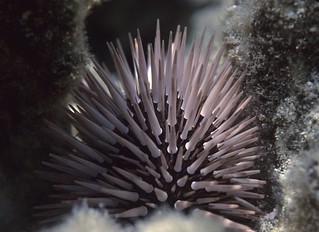 |
| Image from NOAA photo library |
The websites for "urchin trees" and such were running these items for anywhere between 70 to 150.00. But cripes! 150 dollars for sea urchin tree???
So to recap:
1. Starfish decorations are mummified remains of living animals, which had to be killed in order to get you a holiday wreath. I wouldn't lick them.
2. Many of the species used in these industries from the tropical Pacific are probably not sustainable fisheries.
3. Personally, I just think decorating starfishes like Santa Claus is tacky. So, please. just stop. Use sea shells or give people candy. People like candy.
4. Sand dollars are okay. Still possible to kill them for use as decorations. But also possible that they were collected beachwash.
5. Good grief. Who pays 150 dollars for holiday decorations made from beachwash??? or mummified starfish remains??? You know what's good for 150 dollars? chocolate.Send to the Echinoblog. Or charity. charity is good.
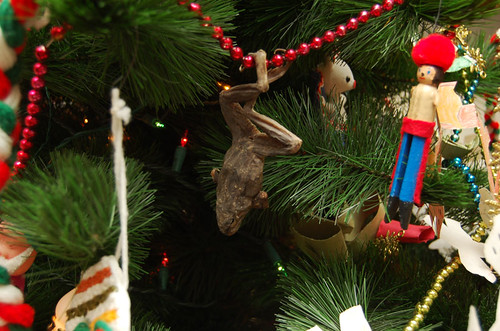

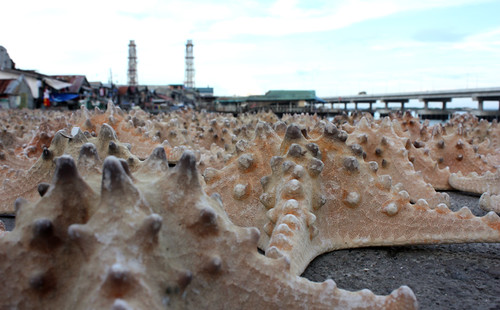




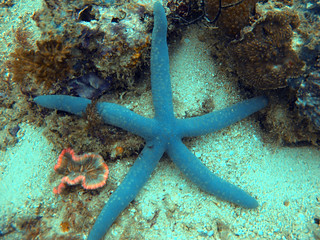
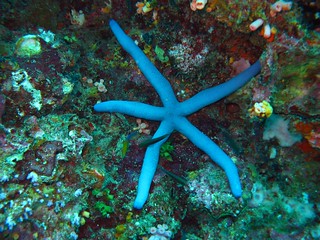
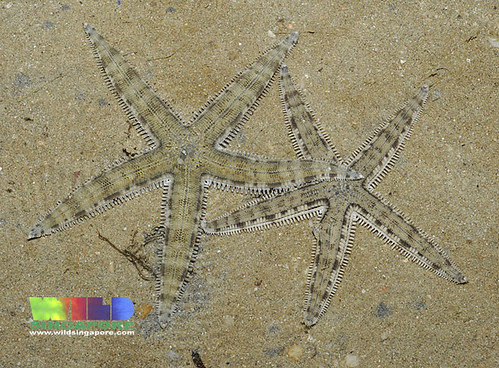
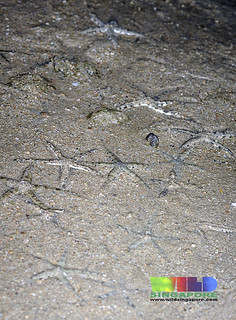
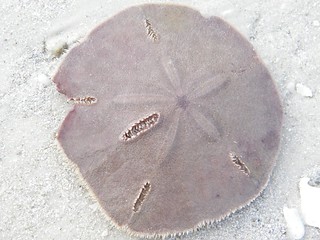
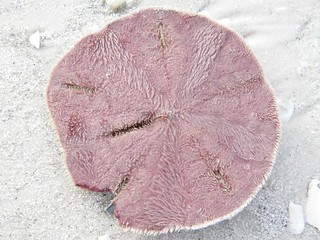


Much lovelier alive.
ReplyDeleteIf the same efforts to preserve their shape and colors are made for the starfish scourge the crown of thorns no doubt they could be used to make this sort of merchandise instead of the benign species you pictured and probably result in the most effective solution to the problem of recurring outbreaks that devastate tropical coral reefs.
ReplyDeletePeople think of them as ugly, because the dried ones look like they were wadded up like trash, before being left to dry.
A few pics I found of properly dried ones looked as good as the ones in your photos, albeit lacking colors due to no effort being made to preserve that feature.
Alive though, the Crown of Thorns can be drab to quite colorful.
What colors it lacks could easily be made up by painting them and thus creating a money making cottage industry in places like the Philippines where jobs are hard to come by.
If the COT had some monetary value controlling coral killing outbreaks would be easy as people would rush to collect them during those times.
Though if they were used that way their population would be kept in check as they'd be used for raw materials.
As for the thorns, people like cactus and all sorts of things with thorns, and the saponins dry out.
I spent the better part of a year finding resin seastars so I could have a few ornaments on my tree. I hate that these are harvested like this and people do not even know that these are real animals...even worse are the dried sea horses you sometimes see..eww!
ReplyDeleteI find dead starfish on the beach a lot and dry them. (Trust me I know they are dead even though starfish don't move a lot) so I just assumed the ones in stores were picked up off beaches too. Sad to think they assumed are killed to sell.
ReplyDeleteTy for this article. Something I didn't realize, even growing up in florida, until 2 events happened in my life 1 I was a teenager swimming at Panama city beach and on a sand barge was so many sand dollars. My sister 14yrs older with her own kids told me it was still alive and to put it back. I remember looking at it. I had only seen the ones my mother had in decorations, typically Floridian decor. The other was a few years ago, on our 17th anniversary trip, one of the places we went was the aquarium in Key West near Mallory point. They have a touch pool, among many other awesome
ReplyDeleteexhibits, I picked up a starfish and it curled its arms around the palm of my hand. So touching. Like a hug from the ocean so to speak. It truly drove home the point of education and conservation. Idt many people realize that they die for crafts. Its almost like taking a fish out of the ocean and pasting it a scrapbook. Sad
Thank you so very much for putting this very detailed article together. It was much needed! I'm so sick of seeing such ignorance continue to be so prevailing. I have shared this article on my FB page. Blessings to you and yours!
ReplyDelete